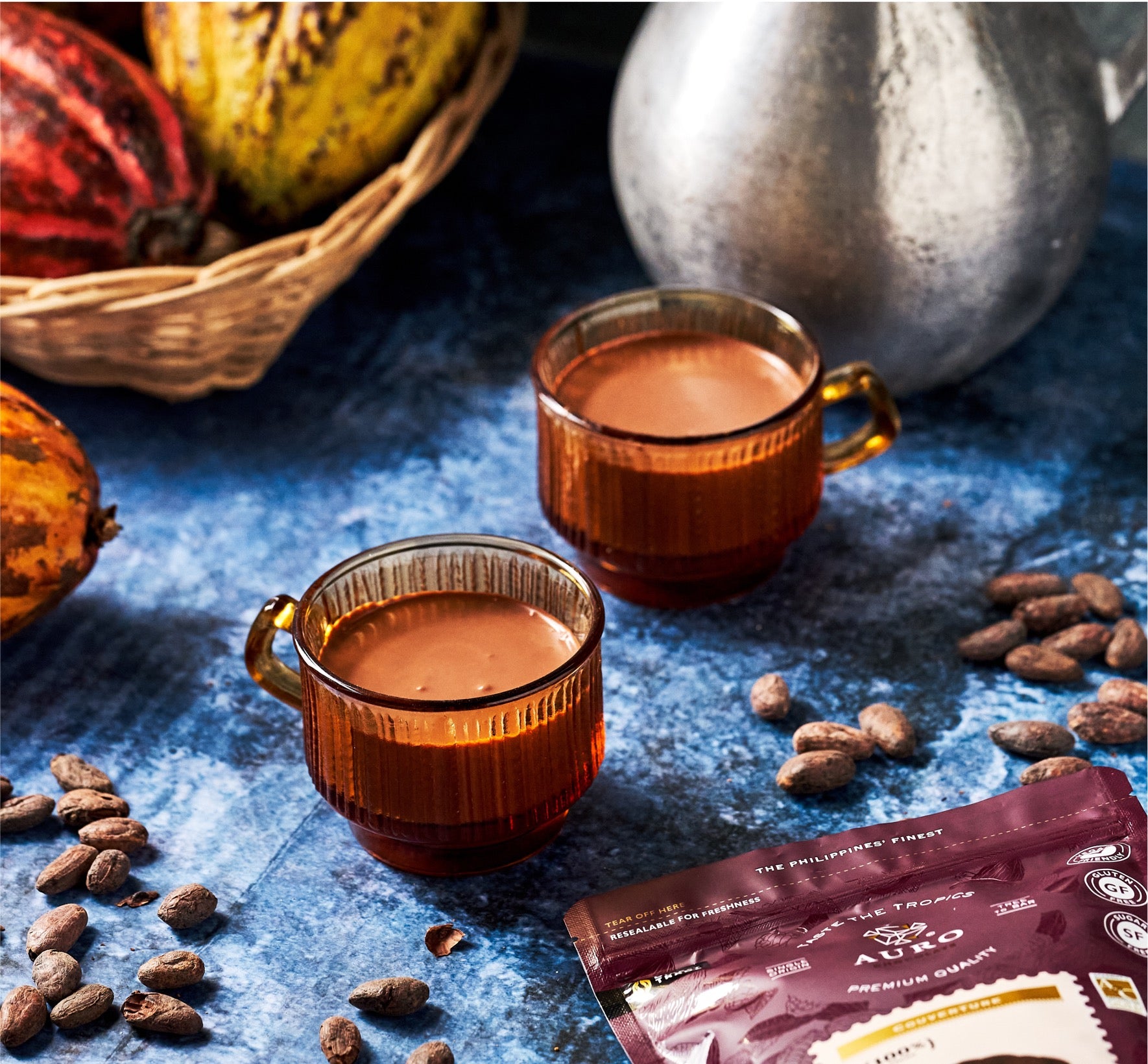From sikwate to champorado, chocolate became a famous product consumed by all types of people in the country regardless of their social class.

There is a certain nostalgia that we associate with chocolate - whether it be memories of a warm homemade cup of sikwate or recollections of the tasty flavors of our favorite chocolate candies as a kid. For Filipinos, we grew up with a cacao tree in the backyard of our homes, tasting its richness straight from the beans. We all have a familiarity with chocolate and it wouldn’t be a surprise if each of us has a story to tell around it. Since its arrival 300 years ago, cacao has simply become a part of our daily life.
The fruit has always been accessible to all types of people in the Philippines - it didn’t matter if you’re rich or poor, an elite or a native, chocolate was simply everywhere and for everyone [1]. By the mid-18th century, the tree was already prevalent in the farms and gardens of Filipinos, majority of it owned by smallholder, indigenous farmers [2]. Homemade chocolate paste made into tableyas is a common household treat enjoyed among all social classes. In Islamic Sulu, it is even the most popular dessert and drink, especially among nobles who ate it with macaroons as they feast [2]. Did you know? Sulu is even possibly one of the first Muslim civilizations documented to have regularly consumed chocolates.
But how did Filipinos buy and consume chocolate before the 20th century?

A Filipino-Chinese chocolate maker [10]. Image Source: The Philippine Islands (1890s) [11]
Before imported brands started to make their way to the Philippines, there were small factories in Manila that produced unbranded chocolates often mixed with unrefined sugar, roasted rice, or pili nuts [2]. Some monasteries even manufacture and make chocolate beverages themselves. But for most Filipinos, pure chocolate tableya, is prepared manually at home including the roasting, shelling, and pounding of beans into paste on a wooden block. These are eventually shaped into tablets and consumed as is or melted into a hot chocolate drink. Later on, chocolate became so popular in the capital that there were even Chinese chocolate grinders or “chocolateros” [3] that went door to door to prepare it for each household. They carry with them a small wooden table or stones that would rest on their knees as they roast and pound chocolate into paste with small marble mortars and heated pestles. These are kneaded into chocolate dough then mixed with sugar, pepper, and other spices to the taste of their customers. At times, they even mark these with the family name or emblem.
The Filipino Chinese community actually still retains their strong connection with tableya to this day. An example of this is their inclusion of the native tableya for Ge-Lai or the sitting period for postpartum women for its health benefits [5].

The different traditional tools used to make sikwate. Source: National Museum of the Philippines
Chocolate is not only popular as a snack, it is also a favorite beverage among Filipinos. The hot beverage, called tsokolate de batirol in Luzon or sikwate in Visayas, or alternatively tsukwate, is consumed by all social classes, albeit in slightly different ways. This drink is normally melted from tableyas over a pot called tsokolateras [3] and whisked with batirol (a version of Mexican molinillo) to get its rich, thick texture. Filipinos normally take homemade tsukwate once or twice a day, mixing it with the usual rice, sugar, or pili nuts to their taste. Meanwhile, the elites prefer to add vanilla to their drink. The Spaniards were fond of sikwate, too - the beverage is asked to be prepared by their servants in the morning and is occasionally an alternative to their afternoon tea.

Chocolate is still enjoyed in tableya form by Filipinos to this day, oftentimes used for sikwate or for their baking needs
Our fondness for the drink was so prevalent that despite the rising popularity of coffee during the late 19th century, sikwate was still the most consumed drink in the Philippines. We drink it in the morning instead of coffee, and in the afternoon instead of tea. Coffee only gained a foothold in the country as the go-to morning drink in the early 20th century under the influence of the Americans. Yet tsokolate remained the go-to afternoon beverage, commonly paired with ensaymada, sopas (a type of biscuit) [4], or any local pastries.
Dishes that included cacao also emerged overtime. One of the favorite dishes of Filipinos until today is tsamporado, a sweet chocolate rice porridge enjoyed in the morning. This originated from the Mexican champurrado or chocolate based atole, a thick chocolate drink mixed with corn. Mexican crew members of the galleon that travelled to the Philippines are believed to have brought this dish with them [6]. At some point during that time, Filipinos must have adapted the dish into a sweeter version that uses rice instead of corn, mixing it with chocolate, sugar, and milk. The rice used is also usually bahaw or day-old rice that was leftover from the day [7]. To this day, it is a beloved breakfast dish all over the country, commonly paired with salty dried fish to provide a balance to the taste.
![Champorado is a chocolate porridge commonly mixed with milk and paired with salty dried fish called tuyo enjoyed by many Filipinos. Source: Casa Baluarte Filipino Recipes [9]](https://cdn.shopify.com/s/files/1/2024/3641/files/Cacao_Story_6_2048x2048.jpg?v=1637907298)
Source: Casa Baluarte Filipino Recipes [9]
More dishes that inserted chocolate includes the suman moron (sticky rice cake with tablea or cacao) of Leyte and Eastern Samar, the baka tula-sog (beef stewed in chocolate sauce) of Davao [8], and the inclusion of cacao in various kakanins (desserts/snacks) like biko (sweet rice cake with coconut), and latik (sweet syrup). There might even be a Filipino version of mole in colonial times that is stewed with beef tongue, or chicken [5].
![One of the famous kakanins in Leyte is Suman Moron, a sticky rice cake made with tableya. Source: AstigVegan.com [13]](https://cdn.shopify.com/s/files/1/2024/3641/files/Cacao_Story_7_2048x2048.png?v=1637907347)
We still carry our fondness for tableya and sikwate to this day, with recipes passed on by generations of Filipinos. Our rich culture around cacao only continues to grow and evolve, all thanks to the humble plant that was brought to our country in the 17th century. But our consumption of chocolate did start to change from being a homemade delicacy - for the next article, we will explore how the consumption of chocolate has evolved from the 20th century to today, influenced by the birth of new technologies and approaches to the craft.
[1] Blair, E. (1911). The Philippine Islands, Vol. 47 (p. 219). Retrieved on November 04, 2020, from https://quod.lib.umich.edu/p/philamer/afk2830.0001.047/223?q1=the+philippine+islands+vol+47
[2] Clarence-Smith, W.G.. (2000). Cocoa and Chocolate, 1765 - 1914. Oxfordshire: Routledge.
[3] Fernandez, D. (2020). Tikim: Essays on Philippine Food and Culture. Mandaluyong: Anvil Publishing, Inc.
[4] Ocampo, A. (17 August 2016). Chocolate and history. Retrieved on January 22, 2020, from https://opinion.inquirer.net/96569/chocolate-and-history
[5] Tan-Zubiri, A. (2018, January 31). No baths for a month after giving birth?. Retrieved on October13, 2021 from https://lifestyle.inquirer.net/285484/no-baths-month-giving-birth/
 Auro PH
Auro PH
 Auro BH
Auro BH
 Auro JP
Auro JP
 Auro TW
Auro TW

